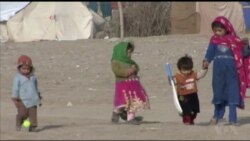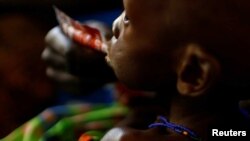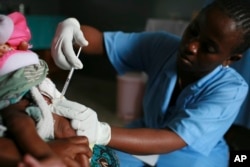In the past 25 years, the world has made remarkable progress in saving the lives of young children, according to the latest report from the United Nations.
In 1990, 35,000 children died every day; last year, 15,000 children and babies died daily, the first time that annual child deaths have fallen below the 6 million mark. But most of these deaths could have been prevented, according to a U.N. interagency group that put together this year’s report on child mortality.
Dr. Flavia Bustreo of the World Health Organization acknowledged the effort it has taken to get to this point. But while the progress is good, it is not enough, she said.
“I need to stress these deaths can be prevented. With the scientific knowledge we have, with the interventions we have, with the resources that we have available, these deaths can be prevented,” said Bustreo, WHO assistant director-general for family, women’s and children’s health.
And that is the tragedy that coincides with this achievement. The report on child and infant mortality states that every year, millions of children younger than 5 die, mostly from malaria, pneumonia and diarrhea. The last two are related to unsanitary conditions.
Malnutrition plays a part
In almost half of these cases, malnutrition weakens the immune system, leaving the child unable to fight off the disease.
Bustreo said access to clean water and exclusive breastfeeding in the first six months of life can reduce an infant’s risk of infection.
Although more children are living to their fifth birthday, Bustreo says the U.N. report shows that 46 percent of child deaths occur shortly after birth. She said the babies who die in the first months of life are born prematurely.
“They (the deaths) are caused by low birth weight. They are caused significantly by sepsis, severe infection that is acquired during the delivery, and they are also caused by asphyxia,” Bustreo said.
While in the womb, the fetus floats in amniotic fluid. This fluid is in the fetus’ mouth, ears and nose. But after birth, if a baby cannot breathe and the birth attendant, if there is one, does not know how to clear the baby’s airways, the baby will suffocate.
The report shows the largest number of newborn deaths occurred in Southern Asia (39 percent), followed by sub-Saharan Africa (38 percent). Five countries accounted for half of all newborn deaths: India, Pakistan, Nigeria, the Democratic Republic of Congo and Ethiopia.
Children younger than 5 also are more likely to die from malaria than adults, which is one reason sub-Saharan Africa and parts of Asia have higher child mortality rates than other parts of the world.
Progress with vaccines
But there are bright spots in the report.
A vaccine for yellow fever spared children’s lives during an outbreak in Angola last year, and a new vaccine for malaria has proved effective for children. Tanzania has tackled air pollution, improved sanitation, and has worked to provide safe drinking water, which has also had a positive impact on child health there.
Bustreo said the concentration of child deaths are increasingly occurring in countries that are either in acute conflict or in a chronic state of strife, such as Somalia, which has the highest child death rate.
“That is important because it also links to not just the medical care, but also the social determinants of health, which, of course, include peace, stability and education, particularly girls’ education,” she said.
Bustreo explains that a girl who is educated can take better care of herself, “she does not become pregnant too early, because that is another important social phenomenon that we’re seeing that is early pregnancy associated with early and forced child marriage.”
Part of the solution lies in multisectorial planning, better training for midwives, training for nurses and vaccines.
Bustreo is dismayed that some parents in developed countries are refusing to get their children vaccinated against these diseases. Ongoing outbreaks of measles in Europe have claimed the lives of 35 children so far.
She said this trend needs to be tackled aggressively. Parents in low- and middle-income countries want to see their children immunized against measles and other disabling or life-threatening diseases.
Despite the overall gains in reducing child mortality, there’s a sense of urgency among health officials. The U.N report said if current trends continue, about 60 million children younger than 5 will die between now and 2030, and half of them will be newborns.












